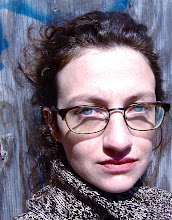And she's not talking about bloggers. Maybe.
Kathryn Shevelow, in Women and Print Culture: The Construction of Feminity in the Early Periodical (Routledge, 1989), writes:
While I was just recently arguing with some nice people at Obsidian Wings that academics were no longer so worked up about identity politics, this bit of reading called to mind all of the women-blogger debates that flare up every so often--and Shevelow's historical point about how women and femininity might become, gradually, objects rather than subjects of discourse is an excellent one.
Generally, I feel that the user-friendliness of blogging takes us away from the message-forum technology towards the publication. These are no longer zines or chatrooms; they're something else, more akin to the earliest print fora. (Granted, most journals and magazines in the eighteenth-century tended to founder for lack of paying readership...) Early print journalism had a few versions of our professorial Bitches, our hilzoys, and our feminist Mormon housewives, but as Shevelow's book warns, these voices can be manouevred out of a dominantly male discourse that prefers to sentimentalize "family"--because it sells. This medium is just getting off the ground, and if I've put any effort into it, you know I'm convinced it's got some staying power. The regular feminist attacks on bloggy complacency, as rote as they might seem, should continue, if only to give us historical dignity.
I am most concerned with the public construction of private life in the form of textual representations. This study will investigate the ways in which the construction of femininity in writing helped to encode a form of feminine authority that defined--that is, both enabled and delimited--a plce for women in print culture. The early popular periodical is a particularly revealing site of this construction, for reasons of both genre and historical development. Through its quotidian engagement with its audience and its historical situation as a 'new' form, organizing a 'new' audience, helping to produce a a newly coalescing ideology of middle-class liberalism, and rewriting gender, the early periodical was engaged in situating itself culturally. It formulated a cultural position in relation to an audience which in some senses, as a self-reflective body of periodical readers, did not exist prior to its organization by the periodical. As the periodical developed, it was constantly engaged in negotiating a relationship to its audience, a relationship variously composed of a mixture of consumer-oriented solicitousness, dependence upon audience complicity in textural production, and assumption of authority to prescribe readers' behavior. On these terms, the early periodical collected, influenced, and was influenced by, its audience. And, as I shall show, it represented that audience textually, not as an undifferentiated mass, but as an organization of specific, 'individual' readers and groups of readers.
My discussion here stresses the multiple ways in which the periodicals addresses and figured their women readers, and in so doing constructed a normative definition of feminity. So that reading the periodical not only brought readers into engagement with 'images of women' but also implicated them in a process of reading which itself was gendered and ideological, exerting a normative force. This process was certainly defined by authorial or editorial intention, but it also was shaped by the historical position and generic properties of the periodical text itself, as I shall show..." (115-116)
While I was just recently arguing with some nice people at Obsidian Wings that academics were no longer so worked up about identity politics, this bit of reading called to mind all of the women-blogger debates that flare up every so often--and Shevelow's historical point about how women and femininity might become, gradually, objects rather than subjects of discourse is an excellent one.
Generally, I feel that the user-friendliness of blogging takes us away from the message-forum technology towards the publication. These are no longer zines or chatrooms; they're something else, more akin to the earliest print fora. (Granted, most journals and magazines in the eighteenth-century tended to founder for lack of paying readership...) Early print journalism had a few versions of our professorial Bitches, our hilzoys, and our feminist Mormon housewives, but as Shevelow's book warns, these voices can be manouevred out of a dominantly male discourse that prefers to sentimentalize "family"--because it sells. This medium is just getting off the ground, and if I've put any effort into it, you know I'm convinced it's got some staying power. The regular feminist attacks on bloggy complacency, as rote as they might seem, should continue, if only to give us historical dignity.



0 Comments:
Post a Comment
<< Home